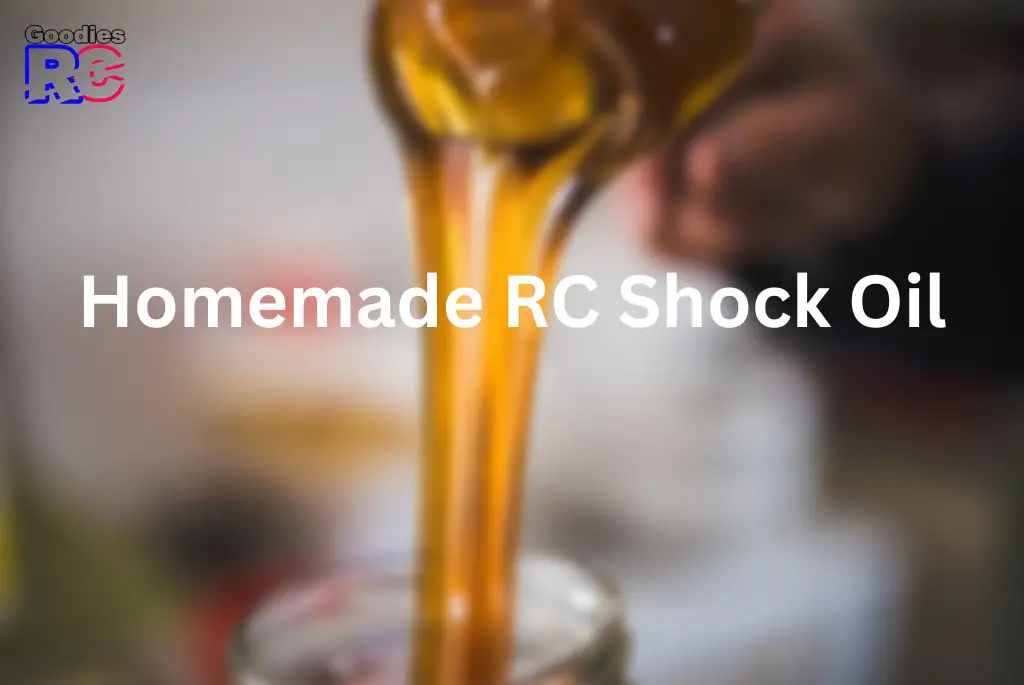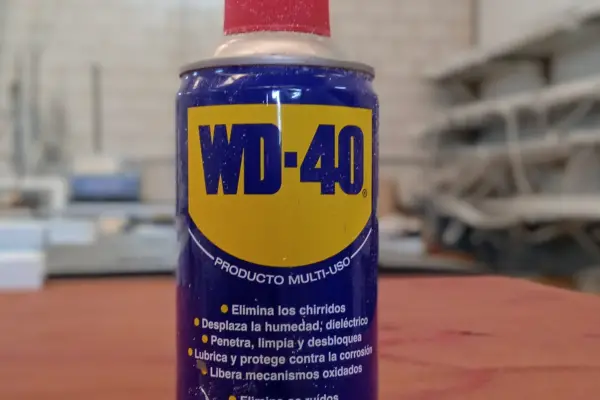Oil-filled shocks give your RC car the best control over bumpy surfaces. For toy-grade RC cars, springs are used to absorb shocks, but they don’t work so well and cause a very bouncy ride. So oil-filled shocks are the best, but what about the oil that goes inside? RC shock oil is a lot more expensive compared to shock oil for motorcycles, so is there a difference?
You can create homemade shock oil by mixing lubricants like transmission and engine oils designed for the automotive industry. You can even use plant-based oils like olive and sunflower oil, but those tend to be too thin and can leak out the shock. Chemicals like brake fluid will damage your shocks.

The amount you mix will depend on the size and weight of the vehicle. Big, heavy RC cars require thick, viscous oil to absorb heavy impacts. Viscosity is the measure of flow in oil and the lower it is, the thinner or runnier the oil. With thin, low-viscosity oil, the shocks won’t absorb as much force as thick high-viscosity oils.
So big RC vehicles use high-viscosity oils because the oil needs to absorb all the force from uneven terrain.
Why Make Homemade RC Shock Oil?
There are a few reasons to make homemade RC shock oil instead of buying it at the hobby shop. First, buying shock oil can be expensive, and making your own can save you a significant amount of money. Second, commercial shock oils may not always be available or might not suit your RC car’s requirements. By making your own shock oil, you can customize the oil’s viscosity to your car’s needs, resulting in better performance.
Guidelines For Making RC Car Shock Oil
To achieve the correct consistency when mixing oils, it’s important to follow a few basic guidelines:
Determine the desired viscosity
The viscosity of shock oil is measured in weight, or viscosities, which is a measurement of how thick the oil is. Different weights of shock oil are used for different types of RC cars and different track conditions. Do your research and determine the appropriate weight of shock oil for your specific car, track, and driving style.
Use high-quality oils
Choose high-quality oils that are specifically designed for use in the automotive industry. Avoid using low-quality or dirty oils, as these can affect the consistency and performance of your shock oil.
Mix the oils carefully
When mixing oils, it’s important to mix them thoroughly and slowly to ensure that the oils blend together evenly. A good rule of thumb is to mix the oils for at least 5-10 minutes, shaking the container periodically to ensure that the oils are fully mixed. (More on how to mix the oils further down).
Test the consistency
Once the oils are mixed, test the consistency by pouring a small amount of the oil onto a flat surface and observing its behavior. If the oil flows too quickly, add more high-viscosity oil to thicken it up. If the oil is too thick, add more low-viscosity oil to thin it out. Repeat this process until you achieve the desired consistency.
Label and store the oil
After you’ve achieved the desired consistency, label the container clearly with the weight of the oil and the date it was mixed. Store the oil in a cool, dry place away from direct sunlight and extreme temperatures.
How To Determine The Correct Oil Mix
You can look inside the other shocks that still have oil in them. You can also compare it to the thickness of the recommended oil to see if it matches up.
But if you want to determine the exact viscosity, you’ll need a viscometer,(Link opens to an Amazon page), these things are expensive! a tool to measure the viscosity of liquids. But keep in mind that it isn’t crucial to know the exact thickness, you can figure it out with the use of trial and error instead of dropping a wad of cash on this tool. Here are some pointers if you still want to get your hands on one.
Choose a viscometer

There are various types of viscometers available on the market, including rotational viscometers, capillary viscometers and falling ball viscometers. Choose a viscometer that is appropriate for the viscosity range of your oil.
Calibrate the viscometer
Before using the viscometer, it needs to be calibrated using a standard reference oil of known viscosity. Follow the manufacturer’s instructions for calibration.
Prepare the oil sample
Fill the viscometer with the oil sample and allow it to reach the same temperature as the viscometer. The oil sample should be free of air bubbles and other impurities.
Take the measurement
Turn on the viscometer and measure the time it takes for the oil to flow through the viscometer. The time it takes for the oil to flow is proportional to its viscosity.
Calculate the viscosity
Use the data you obtain from the viscometer to calculate the viscosity of the oil sample using the appropriate formula.
You’ll need to mix different oils in the correct proportion to achieve the desired viscosity. The specific proportions will depend on the weights of the oils you are using and the desired weight of the shock oil. You can use online calculators or formulas to help you determine the correct proportions.
What Can Be Used Instead Of Shock Oil?
If you’re in a pinch and don’t have any shock oil on hand, you could try using some other types of oil that you might have lying around.
Motor Oil
You can use motor oil, which is designed to lubricate engine parts. However, motor oil may not be the ideal viscosity for your RC shocks and may not provide the same level of performance as RC shock oil until you thicken it up with some transmission or other thick oil.
Transmission Oil

Transmission oil can work for RC shocks, but you need to make sure it isn’t so thick that it stops the shocks from fully functioning. So you’ll have to mix it with another thinner oil, like motor oil, to get the correct balance between thin and thick.
Sewing Machine Oil
Some people swear by using sewing machine oil as an alternative to RC shock oil. Sewing machine oil is a lightweight oil that’s designed for use in sewing machines, but it can also work well in RC shocks. It’s generally inexpensive and easy to find at most craft stores, but you may need to thicken it up slightly with a thicker oil.
Can You Use Cooking Oil In Shocks?
If you’re looking for an alternative to RC shock oil that you might have in your kitchen cupboard, you could try using some vegetable oil. Vegetable oil is a renewable resource and is biodegradable, which makes it an eco-friendly choice and won’t deteriorate the rubbers on the shocks.
However, keep in mind that vegetable oils may not provide the same level of performance as silicone or RC shock oil, so you may need to experiment a bit to find the right viscosity and combination for your RC shocks.
How To Make RC Shock Oil
- Take a clean container and add around 10 ml of your thick oil, like transmission fix, and 10 ml of thinner oil, like motor oil, into it.
- Stir the mixture thoroughly with a stirring rod.
- Using a syringe, draw 5 to 10 ml of the mixture and inject it back into the container. Repeat this process several times to ensure the mixture is well mixed.
- Check the viscosity of the mixture by pushing a drop out of the syringe on a flat surface and observe the flow of the liquid.
- If you have one, use a viscosity measuring device or tool, such as a viscosity cup or a digital viscometer. The ideal viscosity for RC shock oil can vary depending on the type of vehicle and driving conditions, but generally, it should be between 100 and 500 centistoke (cSt).
- If the viscosity is too high, add a small amount of damper oil and stir again. If the viscosity is too low, add a small amount of silicone oil and stir again. Continue to adjust the mixture until you achieve the desired viscosity.
- Once you have achieved the desired viscosity, transfer the mixture to a clean dropper bottle or other suitable container for use. Make sure to label the container with the viscosity and date of creation.
It is important to note that homemade RC shock oil may not perform as well as the shock oil from a hobby shop, and its performance may differ depending on factors such as temperature and humidity. Use at your own risk and always test your vehicle’s performance before use.
Chemicals That Are Not Suitable For RC Shocks
There are certain chemicals that should never be used in RC car shocks, as they can cause damage or degrade the performance of the shocks. These include:
Brake fluid
Brake fluid is corrosive and can damage the seals and o-rings in RC car shocks, leading to leaks and reduced performance.
WD-40

While WD-40 is a popular lubricant for many household applications, it’s not recommended for use in RC car shocks. It’s not specifically designed for this purpose and can cause the seals to swell or degrade over time.
For more on the use of WD 40, please check out my article: Is WD 40 Good For RC Cars?
Silicone sprays
While silicone shock oil is a popular choice for RC car shocks, silicone sprays should not be used in this application. These sprays contain additives that can cause the seals to deteriorate and lead to leaks.
In Summary
Homemade RC shock oil can be made by mixing lubricants like transmission, engine oils, and plant-based oils. Homemade shock oil can be customized to the desired viscosity, and following the guidelines can help achieve the correct consistency.
The use of high-quality oils is important, and testing the consistency is essential before labelling and storing it properly. The correct oil mix can be determined by looking inside other shocks that still have oil in them, or using a viscometer to measure the viscosity.
Alternatives to shock oil, such as motor oil, transmission oil, and sewing machine oil, should only be used when you can’t get your hands on certified shock oil, because their performance may not be the same.
Overall, making homemade RC shock oil can save money and enhance the performance of RC cars if done correctly, but it’s always best to go with what the manufacturer suggests when possible.
I hope that you found this article helpful. Here are some more RC shock-related articles that may be of interest;

